- Home
- About
- Map
- Trips
- Bringing Boat West
- Migration West
- Solo Motorcycle Ride
- Final Family XC Trip
- Colorado Rockies
- Graduates' XC Trip
- Yosemite & Nevada
- Colorado & Utah
- Best of Utah
- Southern Loop
- Pacific Northwest
- Northern Loop
- Los Angeles to NYC
- East Coast Trips
- Martha's Vineyard
- 1 Week in Quebec
- Southeast Coast
- NH Backpacking
- Martha's Vineyard
- Canadian Maritimes
- Ocracoke Island
- Edisto Island
- First Landing '02
- Hunting Island '02
- Stowe in Winter
- Hunting Island '01
- Lake Placid
- Chesapeake
- Provincetown
- Hunting Island '00
- Acadia in Winter
- Boston Suburbs
- Niagara Falls
- First Landing '99
- Cape Hatteras
- West Coast Trips
- Burning Man
- Utah Off-Roading
- Maui
- Mojave 4WD Course
- Colorado River Rafting
- Bishop & Death Valley
- Kauai
- Yosemite Fall
- Utah Off-Road
- Lost Coast
- Yosemite Valley
- Arizona and New Mexico
- Pescadero & Capitola
- Bishop & Death Valley
- San Diego, Anza Borrego, Joshua Tree
- Carmel
- Death Valley in Fall
- Yosemite in the Fall
- Pacific Northwest
- Utah Off-Roading
- Southern CA Deserts
- Yosemite & Covid
- Lake Powell Covid
- Eastern Sierra & Covid
- Bishop & Death Valley
- Central & SE Oregon
- Mojave Road
- Eastern Sierra
- Trinity Alps
- Tuolumne Meadows
- Lake Powell Boating
- Eastern Sierra
- Yosemite Winter
- Hawaii
- 4WD Eastern Sierra
- 4WD Death Valley +
- Southern CA Deserts
- Christmas in Tahoe
- Yosemite & Pinnacles
- Totality
- Yosemite & Sierra
- Yosemite Christmas
- Yosemite, San Diego
- Yosemite & North CA
- Seattle to Sierra
- Southwest Deserts
- Yosemite & Sierra
- Pacific Northwest
- Yosemite & South CA
- Pacific Northwest
- Northern California
- Southern Alaska
- Vancouver Island
- International Trips
- Index
- Tips
- Books
- Photos/Videos
- Search
- Contact
Tuolumne Meadows / Mono Lake, CA
Wednesday, August 12, 2015 - 11:00am by Lolo
305 miles and 6.5 hours from our last stop - 5 night stay
Travelogue
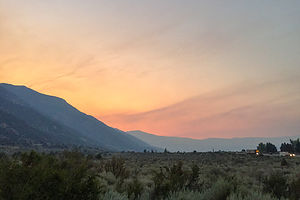 Yosemite Fire Glow from Mono Vista RV ParkAs anyone who has attempted to camp in Yosemite knows, it is extremely difficult to reserve one of its highly-coveted campsites. It requires knowing the exact date and time that the reservation window opens for the dates you are interested in and being poised by a computer when the floodgates open. Usually within 5 minutes of the start time all campsites are gone.
Yosemite Fire Glow from Mono Vista RV ParkAs anyone who has attempted to camp in Yosemite knows, it is extremely difficult to reserve one of its highly-coveted campsites. It requires knowing the exact date and time that the reservation window opens for the dates you are interested in and being poised by a computer when the floodgates open. Usually within 5 minutes of the start time all campsites are gone.
Being veterans of the process, Andrew and Celeste were shrewd enough to nab campsites in Tuolumne Meadow and Crane Flat for the four weekends in August. This particular weekend that we were joining them, they had a tent site in Tuolumne, too small to accommodate our motorhome. At first we considered trying to get one of the first-come-first-served sites, but the entire week before, I kept calling the available campsite hotline just to see whether Tuolumne Meadows sites were obtainable. They all seemed to be taken by 8:00 am.
Herb and I decided to play it safe and reserve space at the Mono Vista RV Resort, a commercial campground just outside the eastern entrance of the park that had views of Mono Lake. We still would have preferred being in Yosemite, but at least there were some redeeming features, like electricity, WiFi, cell coverage, and showers. Plus, it was only a half hour drive into the Park to get to Tuolumne Meadows.
The campground was actually in a very nice setting, set against a mountain backdrop looking out over the lake. Our fellow campers were also quite friendly. There was a very cute elderly couple in the site next to ours. When we got to talking to them, Herb shared the fact that he and I met in 3rd grade and knew each other for over 50 years. Well, that didn’t overly impress them as they had just returned from their 60th high school reunion and had known each other for 70 years. Show offs.
They were an inspirational couple – so active and full of life. Not only were they a pleasure to talk to, but they also gave us a great idea as to what to do tomorrow – hike in the 20 Lakes Basin area, one of the few Yosemite area hikes we had not yet done.
Hiking the 20 Lakes Basin Trail
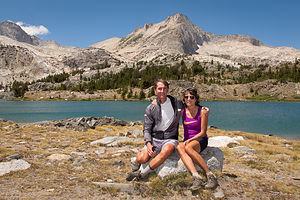 Lolo and Herb at 1 of 20 LakesThe beauty of Yosemite does not stop at its boundaries, as we learned when hiking in the spectacular 20 Lakes Basin area, just outside the eastern boundary of the park in the Hoover Wilderness Area. A very popular route through this region is an 8.4-mile loop hike starting at the south end of 10,087-foot-high Saddlebag Lake.
Lolo and Herb at 1 of 20 LakesThe beauty of Yosemite does not stop at its boundaries, as we learned when hiking in the spectacular 20 Lakes Basin area, just outside the eastern boundary of the park in the Hoover Wilderness Area. A very popular route through this region is an 8.4-mile loop hike starting at the south end of 10,087-foot-high Saddlebag Lake.
It was actually quite easy to get to the trailhead from our campground in Lee Vining. We just took 120 West as if we were going into the park, but after passing Ellery Lake at 10 miles we took a right onto a dirt road signed for Saddlebag Lake and continued for 2.7 miles to a designated parking area near the Resort.
The term resort might be a bit of an exaggeration, but there is a very nice Café and General Store with a cozy fireplace, and a place to rent fishing and pontoon boats. There is also a water taxi which goes between the Resort and the far north end of the lake, saving hikers about a mile and a half. The cost of the ferry is $8 one-way or $13 round-trip.
Since we were there to hike, we skipped the water taxi and headed off along the suggested eastern shore of the lake, which although slightly longer than the trail along the western shore, offers more scenic views.
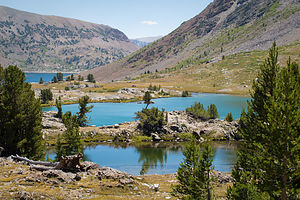 Lakes 1, 2 and 3 of 20 Lakes Basin Trail?Once we reached the ferry dock at the northern end of the lake (at about 2.2 miles) where the lazier hikers were being dropped off, we took a brief side trail to a very photogenic view of blue-green Greenstone Lake with North Peak in the background. Of course we had to stop and ask another couple to take our picture in front of that lovely backdrop.
Lakes 1, 2 and 3 of 20 Lakes Basin Trail?Once we reached the ferry dock at the northern end of the lake (at about 2.2 miles) where the lazier hikers were being dropped off, we took a brief side trail to a very photogenic view of blue-green Greenstone Lake with North Peak in the background. Of course we had to stop and ask another couple to take our picture in front of that lovely backdrop.
From there, we chose to do the loop in a clockwise direction, although now I read that most hikers recommend going counterclockwise. The trail gradually began to ascend as we approached tiny Wasco Lake at 10,325 feet.
All in all, this trail did not have the grueling elevation gains we had become so familiar with on our Yosemite hikes. The trail continued on relatively flat terrain to the larger Steelhead Lake with breathtaking views of North Peak and the granite summit of Shepherd Crest.
After passing a small, unnamed lake (I was still counting it though), we continued through a pretty meadow along a talus slope to Shamrock Lake whose shores were ringed by rocky meadows and stunted white-bark pines growing amidst its granite ledges. North Peak and Mount Conness loomed towards the southwest.
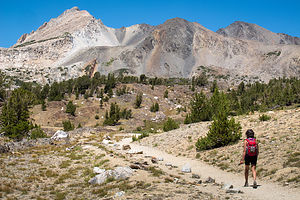 Lolo Hiking 20 Lakes Basin Trail - #1At 4.5 miles, we were slightly past our halfway mark and we had already passed 6 lakes. At this point, the trail got a bit sketchy as we descended the headwall to the basin that cradles Shamrock and Steelhead Lakes towards Helen Lake, which would be the northernmost point of our hike before heading back towards Saddlebag Lake. The trail required a bit of rock scrambling on scree-covered slopes and the crossing of a creek to get around the northern end of Helen Lake. We were back at 10,107 feet, about the elevation we had started at.
Lolo Hiking 20 Lakes Basin Trail - #1At 4.5 miles, we were slightly past our halfway mark and we had already passed 6 lakes. At this point, the trail got a bit sketchy as we descended the headwall to the basin that cradles Shamrock and Steelhead Lakes towards Helen Lake, which would be the northernmost point of our hike before heading back towards Saddlebag Lake. The trail required a bit of rock scrambling on scree-covered slopes and the crossing of a creek to get around the northern end of Helen Lake. We were back at 10,107 feet, about the elevation we had started at.
At the northeast end of Helen Lake, we came to a trail junction. To the left, was the trail towards Lundy Canyon and to the right the continuation of our loop hike back to Saddlebag Lake. Earlier this summer, we had hiked the Lundy Canyon trail from the trailhead on Lundy Canyon Road to the usual turnaround point at the scree-covered canyon walls. We realized now that this was where we would be in a very short distance if we turned left. Perhaps someday I would have the courage to connect the two hikes, but that was for another day.
From the trail junction, we turned right and proceeded up a steep rocky gorge towards Odell Lake, another pretty alpine lake tucked in a rocky bowl and surrounded by steep multi-hued cliffs.
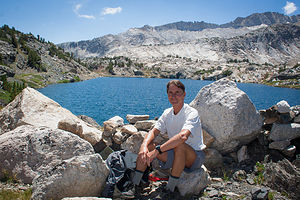 Herb resting on 20 Lakes Basin TrailThen it was on and up through Lundy Pass at 10,345 feet before descending once more to pretty little Hummingbird Lake nestled in a shallow bowl beneath Tioga Crest.
Herb resting on 20 Lakes Basin TrailThen it was on and up through Lundy Pass at 10,345 feet before descending once more to pretty little Hummingbird Lake nestled in a shallow bowl beneath Tioga Crest.
We continued descending to a trail junction near the northern end of Saddlebag Lake. Although we were quite tired, we didn’t even consider taking the ferry back as we wanted to complete the loop as a hike.
The trail along the western shore was nothing like the smooth dirt road we had started out on along the eastern side of the lake. It was very rocky and not exactly what I was looking for at this late point in the hike.
However, we soon were back at the Saddlebag Resort, pleasantly exhausted after what was a really spectacular hike – 8.8 miles, 928 feet of elevation gain, 9 beautiful alpine lakes, and breathtaking views all along the way.
All in all, a very good day.
Kayaking around Tenaya Lake and Rock Climbing at Murphy’s Creek
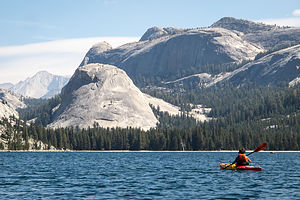 Tenaya Lake Domes with Lolo KayakingThe kids were arriving today. Andrew and Celeste were taking the day off from work and would be arriving early afternoon, but Tommy, who had just started a new job this week, didn’t want to ask for a day off so early in his employment, so he would not be arriving until late tonight. Cell coverage in the Park is very spotty, so we made a plan ahead of time to meet by Tenaya Lake where Herb and I would spend the day kayaking until their arrival.
Tenaya Lake Domes with Lolo KayakingThe kids were arriving today. Andrew and Celeste were taking the day off from work and would be arriving early afternoon, but Tommy, who had just started a new job this week, didn’t want to ask for a day off so early in his employment, so he would not be arriving until late tonight. Cell coverage in the Park is very spotty, so we made a plan ahead of time to meet by Tenaya Lake where Herb and I would spend the day kayaking until their arrival.
Kayaking in this lake was something we had wanted to do on our visit here last August, but a cold front had moved in making it unwise without wetsuits or waterproof clothing. The lake is at 8,150 feet, so even summer days can be quite cold. However, today was a perfectly warm, sunny day.
Tenaya Lake is very pretty, surrounded by classic Yosemite granite peaks and domes. The only downside is its closeness to the road. At least, Andrew would have no trouble finding us in our bright yellow and red kayaks.
We launched from the picnic area and beach on the western end of the lake and paddled counter-clockwise around its shores. The entire trip around was only 2.8 miles, but we spent a good deal of time just floating and photographing the beautiful domes looming over the east end of the lake.
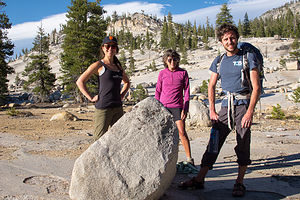 Celeste, Lolo, and Andrew on hike out of Murphy's CreekStill no sign of Andrew and Celeste, so when we got back to the beach, we put the kayaks away and switched to beach chair mode. We knew that relaxing was not going to be part of the itinerary when they arrived, so we took advantage of the last few peaceful moments we had.
Celeste, Lolo, and Andrew on hike out of Murphy's CreekStill no sign of Andrew and Celeste, so when we got back to the beach, we put the kayaks away and switched to beach chair mode. We knew that relaxing was not going to be part of the itinerary when they arrived, so we took advantage of the last few peaceful moments we had.
It wasn’t long before they arrived, smiling and excited for a great weekend ahead. We sat on the beach for about 15 more minutes, before Andrew suggested we go climbing at a nearby crag called Murphy’s Creek. We didn’t even have to move the car, as the trailhead to get there was right across the road from the parking lot.
We hiked for about a mile and a half through woods before coming to a granite slab, which I assumed correctly was our destination. Although I do climb on occasion, this crag was not for me. Yosemite climbing usually involves crack climbing, where you have to jam your hands and feet into a vertical crack to work your way up the rock, much different from the type of climbing Herb and I are used to.
Andrew and Celeste worked on a 5.10d off-width, which involved them cramming and ooching their entire bodies into a wide crack and sort of shimmying their way up the rock. It looked extremely unpleasant. Herb must have agreed, because he decided to sit this one out.
After that, the three of them worked on a very difficult 5.11b crack, which looked even more horrible.
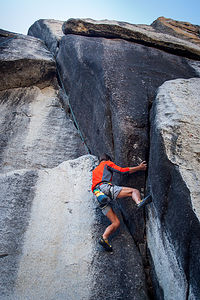 Herb climbing cracks at Murphy's CreekFinally, everyone decided they had tortured themselves enough, we hiked back out with the intention of having celebratory beers in Tuolumne Meadows. A refreshing beer after climbing has become a recent tradition of ours – gives us something to look forward to after hanging from a cliff.
Herb climbing cracks at Murphy's CreekFinally, everyone decided they had tortured themselves enough, we hiked back out with the intention of having celebratory beers in Tuolumne Meadows. A refreshing beer after climbing has become a recent tradition of ours – gives us something to look forward to after hanging from a cliff.
That’s when I broke it to Andrew that I had forgotten to pack beers in the cooler, which was very unlike me. Oops! Fortunately, there is a small grocery store near the Tuolumne Meadows campground where we were able to rectify my oversight.
Refreshments in hand, we found a spot along the path through the meadow to sit and enjoy the unique beauty of this sub-alpine meadow. At an altitude of 8,600 feet, it is quite a bit cooler than the Valley, and also much less crowded. Even the rock formations are different. Rather than 3,000-foot massive granite monoliths, Tuolumne is studded with dozens of more manageably-sized domes, formed by the exfoliation of porphyritic granite.
Andrew and Celeste had come to love this part of Yosemite during their previous weekends here. That’s why I felt very honored that they were willing to give up their highly-coveted and difficult to obtain campsite in the park to come down to Mono Lake to stay in the campground where we were. They said that being together was more important. I thought that was pretty sweet.
Back at the Mono Vista RV Resort, we had a pretty long wait before Tommy’s arrival. In fact, so long that I was the only one that stayed up to greet him. He was coming from San Francisco on his motorcycle after work, so as a Mom I worried about him coming through those steep, windy roads through the park in the dark. No matter how old he gets or how competent he is, I am still his mother. Finally, around 11:30, I heard a motorcycle pull into the campground. To my ears, there could not have been a nicer sound.
Hiking to Lower Cathedral Lake and Rock Climbing by Olmsted Canyon
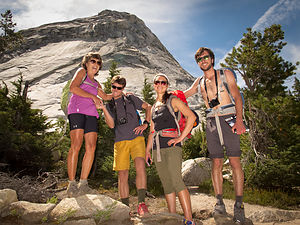 Happy Hikers on Route to Lower Cathedral LakeMost of our Yosemite trips have been to the Valley, so the Tuolumne Meadows area still has so many new places for us to explore and so many trails we haven’t been on.
Happy Hikers on Route to Lower Cathedral LakeMost of our Yosemite trips have been to the Valley, so the Tuolumne Meadows area still has so many new places for us to explore and so many trails we haven’t been on.
We decided to start the day off with a hike to Lower Cathedral Lake and then climb in the afternoon. The trailhead for the hike was located right along the Tioga Pass Road about a half mile west of the visitor center. Parking is allowed along the shoulder of the road, so we found a spot just a quarter mile or so beyond the trailhead.
This hike is part of the iconic John Muir Trail, which extends for over 200 miles from Yosemite Valley to Mount Whitney. We, however, would be only be doing about 4 miles (each way) of it today. Wow! That sounds so wimpy.
This hike is also very popular with backpackers. Wilderness permits are required for overnight backcountry camping in the park, but this was the first time I saw it so strictly monitored. There was a ranger along a trail asking people with large packs that obviously had overnight gear to see their permits.
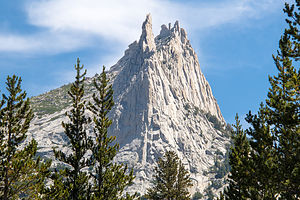 The Elusive Cathedral PeakIn addition to cameras and lunch, Andrew, Tommy, and Celeste had loaded their packs with climbing gear, just in case they decided to climb Cathedral Peak. Fully loaded, we crossed the road, found the trailhead, and began what was pretty much a continuous ascent through a lovely lodgepole pine forest. Good thing Herb and I had already been here a few days to acclimate to the higher elevation, as the trail started at 8,500 feet and only went up from there. We hoped that between the heavier loads they were carrying and their lack of acclimation to the altitude, they would be handicapped enough for us to keep up with them.
The Elusive Cathedral PeakIn addition to cameras and lunch, Andrew, Tommy, and Celeste had loaded their packs with climbing gear, just in case they decided to climb Cathedral Peak. Fully loaded, we crossed the road, found the trailhead, and began what was pretty much a continuous ascent through a lovely lodgepole pine forest. Good thing Herb and I had already been here a few days to acclimate to the higher elevation, as the trail started at 8,500 feet and only went up from there. We hoped that between the heavier loads they were carrying and their lack of acclimation to the altitude, they would be handicapped enough for us to keep up with them.
Eventually we left the forest behind and were treated to our first view of 10,911-foot high Cathedral Peak, one of Yosemite’s iconic granite pinnacles, and the rock formation that Andrew, Tommy, and Celeste were thinking of climbing. It seemed so very far away.
We decided we would hike to Lower Cathedral Lake first and then discuss options for climbing afterwards. So we continued on the John Muir trail until we came to the spur trail for the lake. We were now at the 3.2 mile point of our hike and had made about a 1,000 foot elevation gain. We took a right and walked about another half mile along a stream through a beautiful meadow to the granite shores of pristine Lower Cathedral Lake, set like a jewel in a glacial cirque.
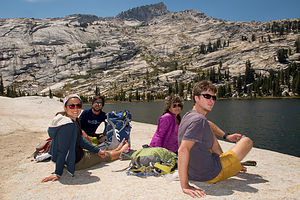 Hikers at Lower Cathedral LakeWell this seemed as good a place as any for lunch and a break from a fairly strenuous hike. The views were breathtaking – nearby Polly Dome and Tenaya Peak providing a picturesque backdrop to the lake, and Cathedral Peak looming over our shoulders from whence we came.
Hikers at Lower Cathedral LakeWell this seemed as good a place as any for lunch and a break from a fairly strenuous hike. The views were breathtaking – nearby Polly Dome and Tenaya Peak providing a picturesque backdrop to the lake, and Cathedral Peak looming over our shoulders from whence we came.
Tommy suggested a refreshing swim, but we ignored him. So he went it alone. Let’s just say it was very brief and literally breathtaking.
After lunch and much photographing of this beautiful spot, we retraced our steps through the meadow back to the junction with the John Muir Trail. This is when much deliberation began as to whether or not to try to climb Cathedral Peak. I knew my vote. I was already tired and the thought of what was required just to get to the base of this formation was not very appealing. The approach alone would take over an hour. If we did this, we would be hiking out in the dark. However, I hate to be a pooper, so I kept my mouth shut.
They know me too well, however, and sensed my apprehension. I think they too had some doubts as to whether we had enough time to do this. Finally, we agreed to put this climb off for another day when we got an earlier start and went directly there. Nobody was disappointed though, because the hike alone had been well worth it.
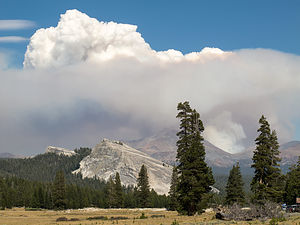 Yosemite Fire Clouds from Tuolomne MeadowsWe hiked the 3.2 miles back down to the trailhead. Back at the car, the boys consulted the climbing guide to select another area to climb where the approach wouldn’t be too long, as it was already mid-afternoon. They settled on Olmsted Canyon, so we headed west on Tioga Pass Road towards Olmsted Point.
Yosemite Fire Clouds from Tuolomne MeadowsWe hiked the 3.2 miles back down to the trailhead. Back at the car, the boys consulted the climbing guide to select another area to climb where the approach wouldn’t be too long, as it was already mid-afternoon. They settled on Olmsted Canyon, so we headed west on Tioga Pass Road towards Olmsted Point.
For anyone driving the Tioga Pass Road, stopping at Olmsted Point is a must. The views of Tenaya Canyon and the northern side of Half Dome will take your breath away. However, we didn’t have much climbing time left in the day and we had been to this viewpoint several times in the past, so we continued on a short distance to the dirt turnout near the mouth of the canyon, which would give us access to the Olmsted Canyon climbing area.
The boys selected a 5.10d climb called Lord Caffeine, which was another one of Yosemite’s classic -- and according to Herb horrible-- crack climbs. Rather than leading what looked like a very difficult climb, the boys took the safer route and hiked around to set up a top rope. After spending a few hours on this climb, I think they came to agree with Herb’s assessment. Celeste managed to get about a third of the way up, Andrew got a little further, but said he wanted to vomit, and Tommy actually got it. Herb didn’t want anything to do with it. Funny how despite all the grunts and groans during the climb, each of them said afterwards, “That was fun!”
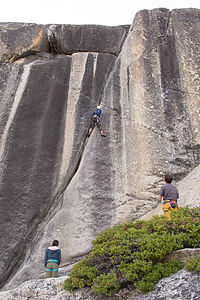 Boys and Celeste on "Lord Caffeine"We had definitely earned our post-hike/climbing celebratory beers, so we headed back to beautiful Tenaya Lake to enjoy the sunset. This time I had not forgotten to pack beers in the cooler. The views were lovely, the company was the best, and the cold beers were very refreshing.
Boys and Celeste on "Lord Caffeine"We had definitely earned our post-hike/climbing celebratory beers, so we headed back to beautiful Tenaya Lake to enjoy the sunset. This time I had not forgotten to pack beers in the cooler. The views were lovely, the company was the best, and the cold beers were very refreshing.
That evening when we drove out of the park, the ranger at the gate told us that once we left we wouldn’t be able to come back. Since we were camping by Mono Lake, we didn’t ask why, but when we saw the flames off to our right, we figured it out. Fires throughout northern California had been an issue all summer, but this one was a little too close for comfort.
When we got back to the motorhome, we saw that our counters were coated with soot from the fire, which had gotten through our open vents. It smelled so strongly, that the kids decided to abandon their tents and spend the night inside the motorhome where we all felt more protected. Thankfully, they had decided to camp with us rather than stay in Tuolumne Meadows, or we would have been totally cut off from each other.
We inquired and found out that the fires were about 5 miles away at Walker Lake, and as of yet, there was no plan to evacuate the Lee Vining area. This was getting a bit scary though.
Saying Goodbye to Kids and Kayaking Mono Lake
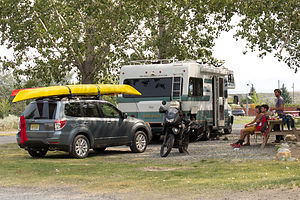 Camping at Mono Vista RV ParkThe next morning we were at a loss as to what to do. The skies were still very smoky and Tioga Pass Road was closed, meaning that not only could we not go into the park to recreate, but the kids had to find another, much longer, route back to San Francisco. Spirits were pretty low.
Camping at Mono Vista RV ParkThe next morning we were at a loss as to what to do. The skies were still very smoky and Tioga Pass Road was closed, meaning that not only could we not go into the park to recreate, but the kids had to find another, much longer, route back to San Francisco. Spirits were pretty low.
We put the decision off for now and went to have breakfast at Whoa Nellie Deli, the only fine restaurant I have ever been to that is in a Mobil gas station. Don’t let the façade fool you. This place is really great, with an interesting menu and excellent food. The experience helped raise spirits quite a bit.
We discussed the possibility of climbing somewhere outside the park, like Mammoth Lakes, but that would mean they would get back to San Francisco very late. Andrew and Celeste decided to start heading back via either Route 50 near South Lake Tahoe or Sonora Pass. Either way would add a good 2 hours from what their drive would have been if they could have driven through the Park.
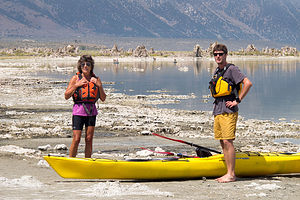 Lolo and Tom Kayaking Mono LakeTommy was in no particular hurry to get back to the city, so he decided to come with us to launch our kayaks in the lake. It really was very hot out, so we hoped that getting out on the water would cool us off.
Lolo and Tom Kayaking Mono LakeTommy was in no particular hurry to get back to the city, so he decided to come with us to launch our kayaks in the lake. It really was very hot out, so we hoped that getting out on the water would cool us off.
Mono Lake is definitely not your typical lake. Besides being over a million years old, and probably the oldest continuously existing lake in North America, it is 2 ½ times saltier than the ocean and 80 times more alkaline. The other unique feature of this lake are its mystical “tufa castles” formed when carbonates in the water combined with calcium from freshwater springs feeding into the lake. As lake levels dropped, these extraordinary-looking knobs, spires, and minarets became exposed. Most of the towers visible in the lake are from 200 to 900 years old and rise as high as 30 feet above the water. Our goal was to paddle amongst the tufas.
The largest concentration of them can be found along the southern shore of the lake at the South Tufa State Reserve, but you can’t launch a kayak from there. The best place to launch is from Navy Beach, which is just ½ mile east of the South Tufa area by water, but a fairly longer drive along a bumpy dirt road to the launch parking lot. From there, we carried our kayaks and gear about 30 yards down to the water.
We only had two kayaks, so Herb suggested that Tommy and I go out, while he took a ride on Tommy’s Kawasaki KLR650 dual sport bike. He had been dying to get his hands on that all weekend. While he rode off into the distance down 120 East, Tommy and I launched the kayaks and paddled amongst the tufas. Although the tufa towers are very visible and close to the shoreline, it was much more fun weaving our way amongst them.
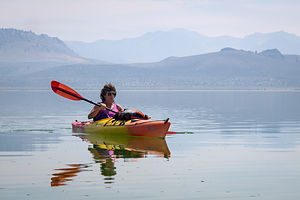 Lolo Kayaking Mono LakeAfter much photogging, we paddled back to Navy Beach where a happy Herb was waiting for us. He had really enjoyed riding Tommy’s bike, hopefully not enough to want him to add one to our already robust arsenal of toys.
Lolo Kayaking Mono LakeAfter much photogging, we paddled back to Navy Beach where a happy Herb was waiting for us. He had really enjoyed riding Tommy’s bike, hopefully not enough to want him to add one to our already robust arsenal of toys.
Tommy had a long ride ahead of him, especially with the detour around Yosemite, so he said his goodbyes and headed north on 395 with the intention of taking the windy road through Sonora Pass.
We had the rest of the day to ourselves, so we took the kayaks back out and paddled towards the Paoha Island in the center of the lake. Funny how distances are so deceptive on the water. The island was just a little over 3 miles from Navy Beach, but I could swear that it kept moving further and further away the more I paddled. At least the lake was calm, at least for now. We would have to keep an eye out for changing conditions because the winds usually pick up in the afternoon making kayaking extremely difficult.
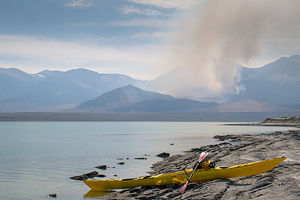 Yosemite Fires Smoke view from Paoha IslandHerb’s kayak is much longer than mine, and therefore much faster – or at least that’s the excuse I use – so before long, he was just a tiny yellow dot in the distance. Rather than get annoyed at being left behind, I decided to enjoy the solitude and sniff the roses. Sometimes I just stopped paddling, leaned back, and gazed at the clouds and mountains in the distance. Hopefully, the massive billows of smoke in the mountains didn’t mean that the fires were getting closer. I started worrying about Lee Vining being evacuated and not being able to get back to our motorhome. Herb says I worry too much, but he wasn’t here right now so I could worry all I wanted.
Yosemite Fires Smoke view from Paoha IslandHerb’s kayak is much longer than mine, and therefore much faster – or at least that’s the excuse I use – so before long, he was just a tiny yellow dot in the distance. Rather than get annoyed at being left behind, I decided to enjoy the solitude and sniff the roses. Sometimes I just stopped paddling, leaned back, and gazed at the clouds and mountains in the distance. Hopefully, the massive billows of smoke in the mountains didn’t mean that the fires were getting closer. I started worrying about Lee Vining being evacuated and not being able to get back to our motorhome. Herb says I worry too much, but he wasn’t here right now so I could worry all I wanted.
Eventually, I paddled up onto the beach where Herb had landed about a half hour ago. We had been to this island on our visit earlier this summer, so I wasn’t as surprised this time when I stepped onto the shore and my feet broke through its crunchy, white moon-like surface, which, like the tufas, was primarily composed of calcium carbonate.
This island is very young in geological years, formed just 350 years ago when a volcanic eruption pushed sediments from the lake bottom and volcanic material 290 feet above the lake surface.
It was really hot and there was absolutely no shade to be found on the island. Herb, who I think is part lizard, loved it. After about an hour of sweating and swatting brine flies, I found myself getting cranky and anxious to get back out on the water where it was significantly cooler. Plus, those fires in the not so far distance were making me nervous.
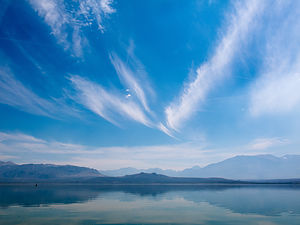 Mono Lake Sky with Tiny Lolo KayakingI think Herb was disappointed that I wanted to leave so soon, but I just couldn’t take the heat. Since he is a faster kayaker than me, I suggested he stay longer and just catch up to me when he was ready to leave.
Mono Lake Sky with Tiny Lolo KayakingI think Herb was disappointed that I wanted to leave so soon, but I just couldn’t take the heat. Since he is a faster kayaker than me, I suggested he stay longer and just catch up to me when he was ready to leave.
He gave me the GPS so that I could more easily track a straight line to Navy Beach, rather than zigzagging my way across the lake, turning a 3 mile paddle into a 5 mile one. Plus, it told me my progress in tenths of a mile, which I found very rewarding.
I resumed my routine – paddle for awhile, rest and gaze at clouds and mountains, worry about fires, paddle again, gaze and worry again, and so on. Thanks to my trusty GPS, I arrived back at Navy Beach just about the same time Herb did.
We loaded the kayaks on the car and headed back to Mono Vista RV Park. The smoke was still pretty bad, and Tioga Pass Road was still closed, but 395 and the campground were still open. I’m not sure what we would have done if they weren’t.
Description
Yosemite – Tuolumne Meadows
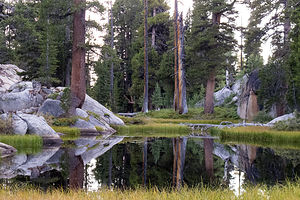 Pond on Hike Out from Olmsted CanyonIn my past Yosemite trip stop descriptions, I have focused on Yosemite Valley. However, this time our foray into Yosemite was limited to beautiful Tuolumne Meadows along the Tioga Pass Road in the northern part of the park.
Pond on Hike Out from Olmsted CanyonIn my past Yosemite trip stop descriptions, I have focused on Yosemite Valley. However, this time our foray into Yosemite was limited to beautiful Tuolumne Meadows along the Tioga Pass Road in the northern part of the park.
Tuolumne Meadows is very different from Yosemite Valley. At an altitude of 8,600 feet, it is high country and therefore, quite a bit cooler and wetter. As its name implies, Tuolumne is a beautiful sub-alpine meadow along the Tuolumne River, surrounded by rugged snow-covered mountain peaks and glacially-carved granite domes. The rock is porphyritic granite, which has a tendency for exfoliation, resulting in the distinctive dome shapes found here.
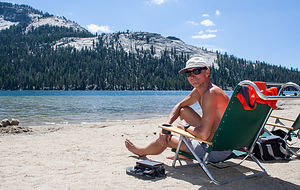 Herb beaching on Tenaya LakeHiking and rock climbing are extremely popular in this section of the park and tend to be much less crowded than the Valley. In contrast to the big walls in the Valley, the rock climbing routes on the major domes in the Meadow are shorter.
Herb beaching on Tenaya LakeHiking and rock climbing are extremely popular in this section of the park and tend to be much less crowded than the Valley. In contrast to the big walls in the Valley, the rock climbing routes on the major domes in the Meadow are shorter.
There are very few services in Tuolumne and the Tioga Pass Road is usually only open from Memorial Day through late October / early November, depending on the snowfall. During the summer (mid-June to mid-September), camping is available at Tuolumne Meadows Campground. It is extremely popular, so reservations are strongly recommended. However, there are also many sites saved as first-come-first-served. There is also a small grocery store, grill, post office, and gas station.
Mono Lake
Mono Lake is located just off Highway 395 near the town of Lee Vining, California, 13 miles east of Yosemite National Park. Mono Lake is extremely unique. First of all, at over 1 million years of age, it is one of the oldest continuously existing lakes in the continent. Secondly, it is about 2 ½ times as salty as the sea and about 80 times as alkaline. This is because Sierra streams flow into Mono Lake bringing trace amounts of salts and minerals, but the lake has no outlet other than evaporation. As a result, the concentration levels of salts and minerals keeps growing each year. Thirdly, and the main reason Mono Lake is so popular, are the hundreds of spectacular “tufa towers” that rise from the lake. These intriguing calcium-carbonate sculptures were formed beneath the water when carbonates in the water combined with calcium from freshwater springs feeding into the lake. As lake levels dropped, these extraordinary-looking knobs, spires, and minarets became exposed. Most of the towers visible in the lake are from 200 to 900 years old and rise as high as 30 feet above the water.
A good place to start your visit is at the Mono Basin Scenic Area Visitor Center, located just off Highway 395, north of Lee Vining, where you will find exhibits about both the natural and human history of the Mono Basin.
One of the best places to view the tufas is at the Mono Lake Tufa State Reserve along the southern shoreline of the lake. The trailhead for the south tufa castles and Navy Beach is at the edge of the parking lot. During the summer, rangers lead walking tours 3 times a day (10am, 1pm, and 6pm), but if your not lucky enough to catch one of these, there are plenty of informative signboards along the trail. A short walk along the mile-long trail brings you to the strange and fanciful tufa castles at Navy Beach. A swim in the buoyant waters of Mono Lake is a memorable experience, as long as you are willing to step through the millions of harmless alkali flies that line the water’s edge. It’s fun to watch what at first looks like black sand part before you.
Surrounded by volcanic hills, Mono Lake is also a geologist's paradise. The two major islands in the lake are actually volcanic domes. The large black island, which the Kuzedika Indians named Negit, meaning “blue-winged goose,” erupted about 1700 years ago. The white island, which the Native Americans named Paoha, meaning “spirits of the mist,” erupted 250 years ago.
Bird watching and photography are other popular activities at Mono Lake.
- ‹ previous
- 2 of 8
- next ›
Tuolumne Meadows / Mono Lake location map in "high definition"
Javascript is required to view this map.
